Section 6.1 Areas between Curves
Learning Objectives.
Determine the area of a region between two curves by integrating with respect to the independent variable.
Find the area of a compound region.
Determine the area of a region between two curves by integrating with respect to the dependent variable.
In Introduction to Integration 5, we developed the concept of the definite integral to calculate the area below a curve on a given interval. In this section, we expand that idea to calculate the area of more complex regions. We start by finding the area between two curves that are functions of \(x,\) beginning with the simple case in which one function value is always greater than the other. We then look at cases when the graphs of the functions cross. Last, we consider how to calculate the area between two curves that are functions of \(y.\)
Subsection 6.1.1 Area of a Region between Two Curves
Let \(f(x)\) and \(g(x)\) be continuous functions over an interval \([a,b]\) such that \(f(x)\geq g(x)\) on \([a,b].\) We want to find the area between the graphs of the functions, as shown in the following figure.
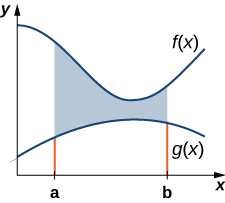
As we did before, we are going to partition the interval on the \(x\text{ -axis }\) and approximate the area between the graphs of the functions with rectangles. So, for \(i=0,1,2,\dots ,n,\) let \(P={x_i}\) be a regular partition of \([a,b].\) Then, for \(i=1,2,\dots ,n,\) choose a point \(x_i^* \in [x_{i-1},x_i],\) and on each interval \([x_{i-1} ,x_i]\) construct a rectangle that extends vertically from \(g(x_i^* )\) to \(f(x_i^* ).\) Figure 6.4(a) shows the rectangles when \(x_i^* \) is selected to be the left endpoint of the interval and \(n=10.\) Figure 6.4(b) shows a representative rectangle in detail.
Note 6.3.
Use this calculator 1 to learn more about the areas between two curves.
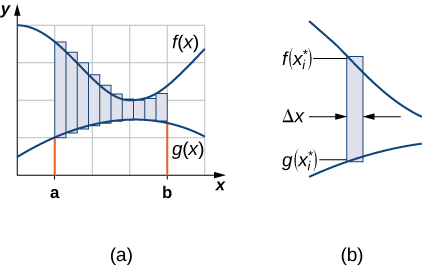
The height of each individual rectangle is \(f(x_i^* )-g(x_i^* )\) and the width of each rectangle is \(\Delta x.\) Adding the areas of all the rectangles, we see that the area between the curves is approximated by
This is a Riemann sum, so we take the limit as \(n\to \infty \) and we get
These findings are summarized in the following theorem.
Theorem 6.5. Finding the Area between Two Curves.
Let \(f(x)\) and \(g(x)\) be continuous functions such that \(f(x)\geq g(x)\) over an interval \([a,b].\) Let \(R\) denote the region bounded above by the graph of \(f(x),\) below by the graph of \(g(x),\) and on the left and right by the lines \(x=a\) and \(x=b,\) respectively. Then, the area of \(R\) is given by
We apply this theorem in the following example.
Example 6.6. Finding the Area of a Region between Two Curves 1.
If \(R\) is the region bounded above by the graph of the function \(f(x)=x+4\) and below by the graph of the function \(g(x)=3-\frac{x}{2}\) over the interval \([1,4],\) find the area of region \(R.\)
The region is depicted in the following figure.
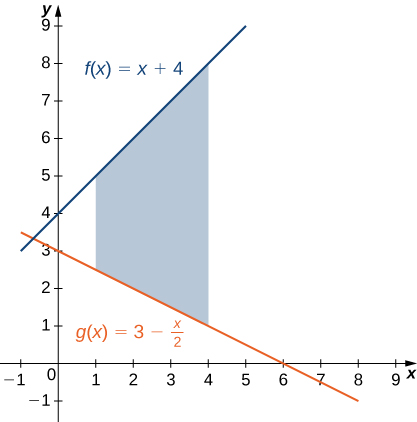
We have
The area of the region is \(\frac{57}{4}\text{ units }^2.\)
Checkpoint 6.8.
If \(R\) is the region bounded by the graphs of the functions \(f(x)=\frac{x}{2}+5\) and \(g(x)=x+\frac{1}{2}\) over the interval \([1,5],\) find the area of region \(R.\)
Graph the functions to determine which function’s graph forms the upper bound and which forms the lower bound, then follow the process used in Example 6.6.
\(12\) units \(^2\)
Example 6.9. Area between Revenue and Cost Functions.
Suppose your daily revenue from selling used DVDs is \(R(t)=100+5t\) dollars per day while you daily costs are \(C(t)=90+5t\) dollars per day, where \(t\) represents the number of days from the beginning of the week. If \(R\) is the region bounded by the graphs of the functions \(R(t) \text{ and } C(t)\) over the interval [0,5], find the area of region \(R\text{.}\) What does the answer represent?The region is depicted in the following figure.
We have
The area of the region is \(50\) units \(^2\text{.}\) Recall from section 1.3, [cross-reference to target(s) "profit_1.3" missing or not unique]. This gives us that the area of the region represents the the total profit over 5 days.
In Example 6.6, we defined the interval of interest as part of the problem statement. Quite often, though, we want to define our interval of interest based on where the graphs of the two functions intersect. This is illustrated in the following example.
Example 6.11. Finding the Area of a Region between Two Curves 2.
If \(R\) is the region bounded above by the graph of the function \(f(x)=9-(x/2)^2\) and below by the graph of the function \(g(x)=6-x,\) find the area of region \(R.\)
The region is depicted in the following figure.
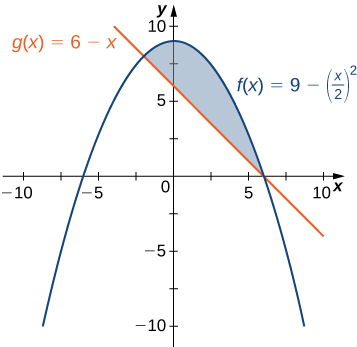
We first need to compute where the graphs of the functions intersect. Setting \(f(x)=g(x),\) we get
The graphs of the functions intersect when \(x=6\) or \(x=-2,\) so we want to integrate from \(-2\) to \(6.\) Since \(f(x)\geq g(x)\) for \(-2\leq x\leq 6,\) we obtain
The area of the region is \(64/3\) units \(^2\text{.}\)
Checkpoint 6.13.
If \(R\) is the region bounded above by the graph of the function \(f(x)=x\) and below by the graph of the function \(g(x)=x^4,\) find the area of region \(R.\)
Subsection 6.1.2 Areas of Compound Regions
So far, we have required \(f(x)\geq g(x)\) over the entire interval of interest, but what if we want to look at regions bounded by the graphs of functions that cross one another? In that case, we modify the process we just developed by using the absolute value function.
Theorem 6.14. Finding the Area of a Region between Curves That Cross.
Let \(f(x)\) and \(g(x)\) be continuous functions over an interval \([a,b].\) Let \(R\) denote the region between the graphs of \(f(x)\) and \(g(x),\) and be bounded on the left and right by the lines \(x=a\) and \(x=b,\) respectively. Then, the area of \(R\) is given by
In practice, applying this theorem requires us to break up the interval \([a,b]\) and evaluate several integrals, depending on which of the function values is greater over a given part of the interval. We study this process in the following example.
Example 6.15. Finding the Area of a Region Bounded by Functions That Cross.
If \(R\) is the region between the graphs of the functions \(f(x)=-x\) and \(g(x)=2-x^2\) over the interval \([-2,2],\) find the area of region \(R.\)
Let's first find where the graphs intersect.
The graphs of the functions intersect at \(x=-1\text{ and }x=2.\) The region is depicted in the following figure.

For \(x\in[-2,-1],\) \(f(x)\geq g(x)\text{.}\) On the other hand, for \(x\in[-1,2],\) \(g(x)\geq f(x)\text{.}\) Then,
The area of the region is \(\frac{19}{3}\) units \(^2\text{.}\)
Checkpoint 6.17.
If \(R\) is the region between the graphs of the functions \(f(x)=x\) and \(g(x)=x^2\) over the interval \([0,2],\) find the area of region \(R.\)
Example 6.18. Finding the Area of a Complex Region.
Consider the region depicted in Figure 6.19. Find the area of \(R.\)
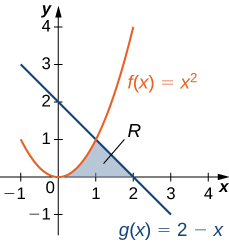
As with [cross-reference to target(s) "fs-id1167793263971" missing or not unique], we need to divide the interval into two pieces. The graphs of the functions intersect at \(x=1\) (set \(f(x)=g(x)\) and solve for \(x\)), so we evaluate two separate integrals: one over the interval \([0,1]\) and one over the interval \([1,2].\)
Over the interval \([0,1],\) the region is bounded above by \(f(x)=x^2\) and below by the \(x\)-axis, so we have
Over the interval \([1,2],\) the region is bounded above by \(g(x)=2-x\) and below by the \(x\text{ -axis, }\) so we have
Adding these areas together, we obtain
The area of the region is \(5/6\) units \(^2\text{.}\)
Checkpoint 6.20.
Consider the region depicted in the following figure. Find the area of \(R.\)
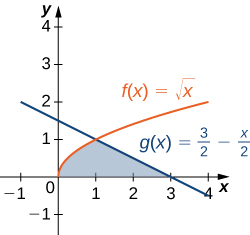
Subsection 6.1.3 Key Concepts
Just as definite integrals can be used to find the area under a curve, they can also be used to find the area between two curves.
To find the area between two curves defined by functions, integrate the difference of the functions.
If the graphs of the functions cross, or if the region is complex, use the absolute value of the difference of the functions. In this case, it may be necessary to evaluate two or more integrals and add the results to find the area of the region.
Subsection 6.1.4 Key Equations
Area between two curves, integrating on the \(x\)-axis \(A=\displaystyle{ \int_{a}^{b} [f(x)-g(x)]dx}\)
http://www.openstax.org/l/20_CurveCalc